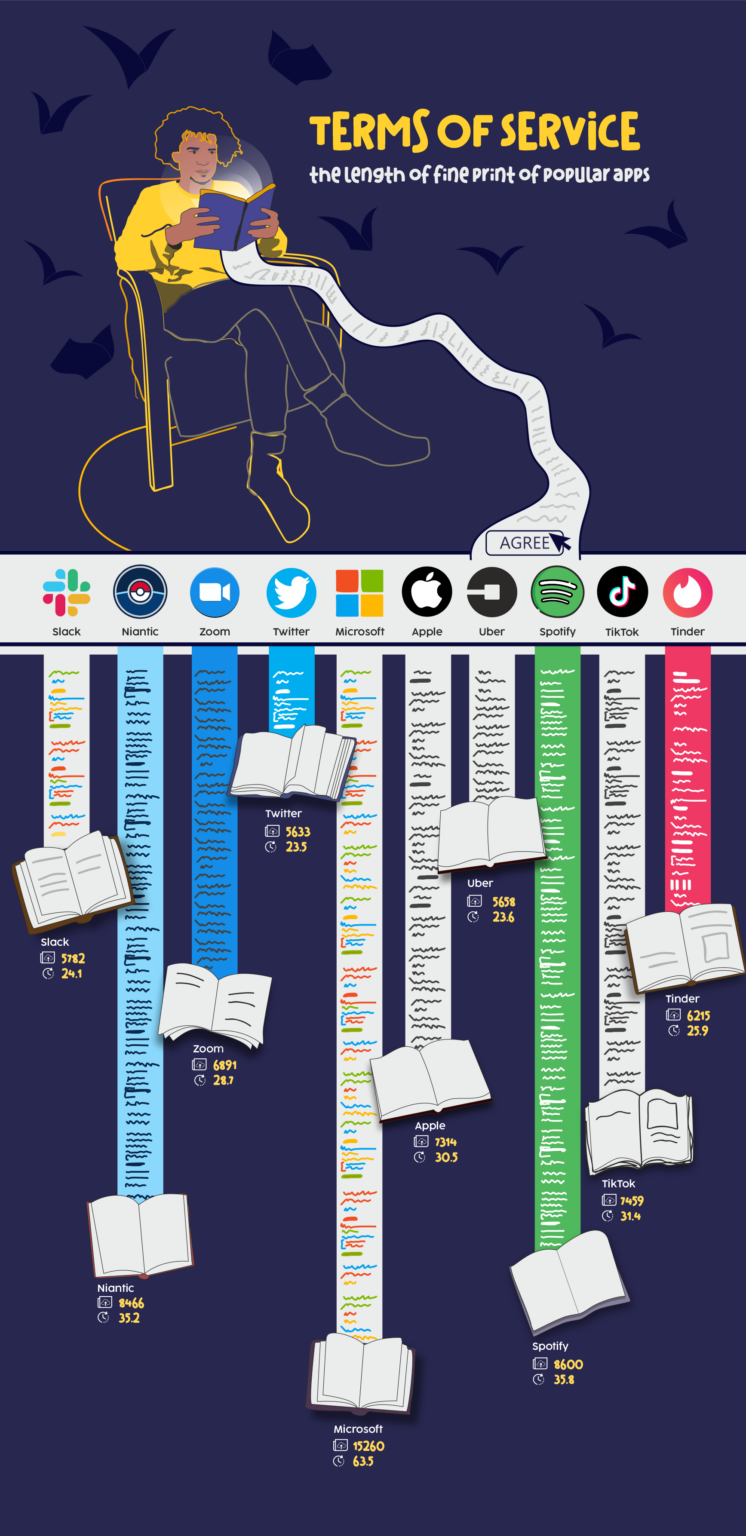Do you switch off whenever you see the words, ‘Terms and Conditions?’ Perhaps you simply click ‘ok’ or ‘accept’ rather than reading any of the small print. If you do, however, you could be giving your data away, or agreeing to terms you don’t really understand.
Trevor Cooke, the online privacy expert at EarthWeb, discusses why the length of the legalese some of the top apps and services employ could be a cause for concern.
| App Or Service | Word Count | How Many Minutes To Read (based on 240 wpm) | Novelette Or Short Story Of Same Length |
| Microsoft | 15,260 | 63.5 | ‘The Little Prince’ by Antoine de Saint-Exupéry (16,534 words) |
| Spotify | 8,600 | 35.8 | ‘Leiningen Versus the Ants’ by Carl Stephenson (8,881 words) |
| Niantic (Pokemon Go) | 8,466 | 35.2 | ‘The Most Dangerous Game’ by Richard Connell (8,426 words) |
| TikTok | 7,459 | 31.4 | ‘The Consul’ by Richard Harding Davis (7,446 words) |
| Apple (Media Services) | 7,314 | 30.5 | ‘The Purloined Letter’ by Edgar Allan Poe (7,396 words) |
| Zoom | 6,891 | 28.7 | ‘Ethan Brand’ by Nathaniel Hawthorne (6,826 words) |
| Tinder | 6,215 | 25.9 | ‘The Pit and the Pendulum’ by Edgar Allan Poe (6,155 words) |
| Slack | 5,782 | 24.1 | ‘Mademoiselle Pearl’ by Guy de Maupassant (5,751 words) |
| Uber | 5,658 | 23.6 | ‘A Blackjack Bargainer’ by O Henry (5,672 words) |
| 5,633 | 23.5 | ‘The Premature Burial’ by Edgar Allan Poe (5,637 words) |
What Are Digital Contracts?
Trevor explains, ‘Digital contracts are agreements between two parties that are legal, valid, and enforceable by law, according to the Information Technology Act 2000. They define the parties involved, include contact information, and set out the contract wording.’ An ‘agree’ or ‘accept’ button is equal to a written signature, but despite their legal power, 97% of 18-34 year-olds said they never read the terms and conditions of the apps they use every day.
The Reading Time
The average silent reader consumes around 240 words per minute (WPM). The data in the table reveals a significant variance in the word count and amount of reading time needed for the various terms of service and privacy policies.
Microsoft leads the way, requiring over an hour of reading time! As Trevor says, ‘It’s understandable that people are tempted to avoid it – there are, after all, better things to spend an hour on than untangling complex legal jargon!’ Twitter’s legal documents are at the other end of the spectrum, but still require nearly half an hour on average to get through, and individual reading speeds can vary widely, especially when dealing with complex legal jargon.
The Implications
The extensive length of these T’s & C’s reflects the complexity and scope of the services provided by these companies and is required to protect them from legal action. However, there are questions about the accessibility of such important information to the average person; even if they were to take the time to read through all the Terms and Conditions of their favourite app, do people fully understand the conditions they’re accepting? This can create a gap between user expectations and the actual service they receive.
One argument is that companies should produce more user-friendly legal documents – using summaries, bullet points, and interactive guides. Trevor says, ‘The fine print studied wasn’t as lengthy as full-blown books, but the Facebook Terms of Service equal the U.S. Constitution. If the wording were shorter and clearer, all parties would know exactly what they’re agreeing to. And if the legalese is still needed for legal reasons, I would suggest having shorter, easier summaries written in simpler language to ensure the customer understands.’







